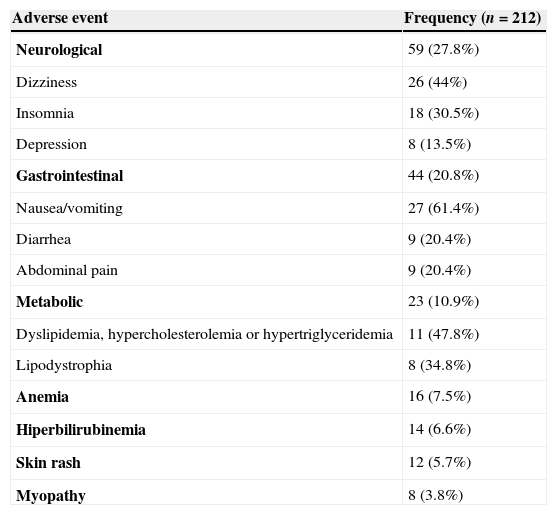The increasing number of available antiretroviral drugs (ARV) for treating HIV-1 infection has promoted an amazing reduction on AIDS-associated morbidity and mortality. However, adverse events are still a frequent finding in on-treatment patients, and may have a negative impact on patient's quality of life, adherence to therapy, and long term health problems.1 In Brazil, we have only scarce data on the frequency of such problems, and we need to better define what is the real magnitude of these problems in HIV patients initiating antiretroviral therapy.
The present work is a pilot, retrospective cohort study, in which we reviewed clinical charts of 100 patients (75% males) who started ARV therapy between 2003 and 2009, in Salvador, Bahia state, Brazil. We recorded the number of ARV regimens used by each individual, and the related problems detected during patient's follow up.
Most patients (66%) were black, as expected for a city with the characteristics of Salvador. Mean age was 43 years (range 27–67 years), and 68% were infected by unprotected homosexual contact. A total of 212 different ARV regimens were used by the group during follow up period. We found a high (75%) frequency of adverse events (AE). Table 1 summarizes the main safety problems detected in the study sample (only those AE with a frequency equal or higher than 5% were described). Of note, patients older than 50 years were more likely (58%) to present AE after starting ARV therapy.
Frequency of main (>5%) adverse events associated with the first antiretroviral regimen.
| Adverse event | Frequency (n=212) |
|---|---|
| Neurological | 59 (27.8%) |
| Dizziness | 26 (44%) |
| Insomnia | 18 (30.5%) |
| Depression | 8 (13.5%) |
| Gastrointestinal | 44 (20.8%) |
| Nausea/vomiting | 27 (61.4%) |
| Diarrhea | 9 (20.4%) |
| Abdominal pain | 9 (20.4%) |
| Metabolic | 23 (10.9%) |
| Dyslipidemia, hypercholesterolemia or hypertriglyceridemia | 11 (47.8%) |
| Lipodystrophia | 8 (34.8%) |
| Anemia | 16 (7.5%) |
| Hiperbilirubinemia | 14 (6.6%) |
| Skin rash | 12 (5.7%) |
| Myopathy | 8 (3.8%) |
Incidence of AE was the main reason for changing ARV drugs in 53% of cases. The AE significantly associated with switching therapy were neurological (34%; p=0.02), gastrointestinal (26%; p=0.03) and metabolic (10%; p=0.05). Again, switching therapy was more likely to occur in older patients (aged more than 50 years) than in younger ones.
In the present study, we detected a high rate of AE in patients initiating ARV therapy in the city of Salvador, similar to that found in other studies.2,3 The high frequency of neurological and gastrointestinal events was clearly associated with a higher likelihood of changing the initial ARV regimen. Although the small number of cases limits the overall reach of our findings, it provides clear evidence on the importance of a careful choice of drugs to compose the first ARV regimen, in order to avoid the risks of low adherence, virological failure, and early switch of ARV drugs. It becomes even more important in face of the recent changes observed in the Brazilian official recommendations to start therapy with a pre-defined regimen, limiting the room for tailoring the regimen to an individual patient's need.
Conflicts of interestThe authors declare no conflicts of interest.





